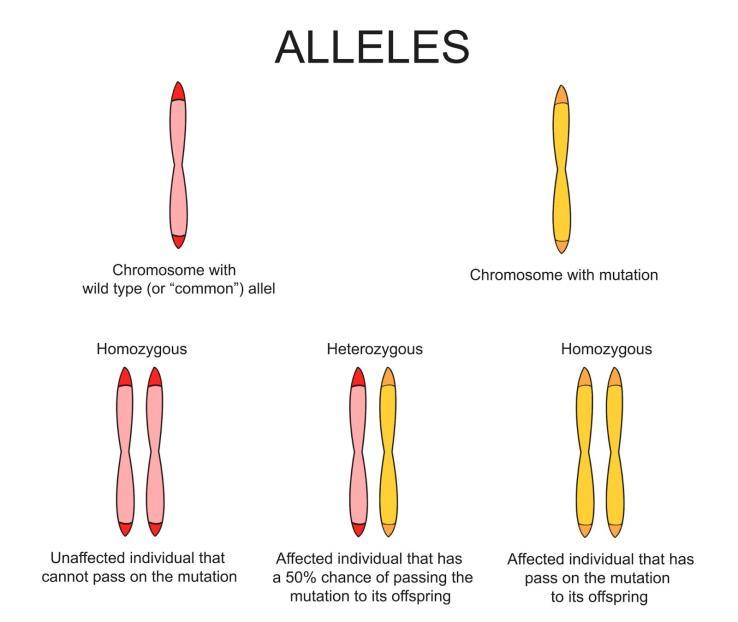
What is an allele?
(a) Another name for chromosome
(b) A genetic condition
(c) A pair of a gene that code for a certain characteristic
(d) A pair of strands in a chromosome
Answer
493.8k+ views
Hint: Each of two or more copies of a gene is an allele. For each gene, a human inherits two alleles, one from each parent. The allele is a type of a gene variant.
Complete answer:
An allele is an alternate type of a gene (one member of a pair) which is located on a particular chromosome at a particular location. These DNA codings determine distinct characteristics that can be passed through sexual reproduction from parents to offspring.
There can be various extremes of size for alleles. An allele can be a single nucleotide polymorphism (SNP) at the lowest possible size. It can be up to several thousand base pairs in length at the upper end. The majority of alleles contribute to little or no measurable improvement in the protein role for which the gene codes.
Additional information:
At some stage in their life cycle, all multicellular species have two sets of chromosomes; that is, they are diploids. The chromosomes may be combined in this situation. Each chromosome in the pair contains the same genes along the length of the chromosome, in the same order and position. For a given gene, whether the two chromosomes contain the same allele, they are homozygous with respect to that gene, along with the individual. They, and the organism, are heterozygous with respect to that gene if the alleles are different.
So, the correct answer is ‘a pair of genes that code for a certain characteristic’.
Note:
Different characteristics of an organism, such as hair color or eye color, are regulated by genes, but the actual expression of a character depends on which allele is dominant. Humans also have two copies of each gene to store alleles, as well as other life forms that have two copies of each chromosome.

Complete answer:
An allele is an alternate type of a gene (one member of a pair) which is located on a particular chromosome at a particular location. These DNA codings determine distinct characteristics that can be passed through sexual reproduction from parents to offspring.
There can be various extremes of size for alleles. An allele can be a single nucleotide polymorphism (SNP) at the lowest possible size. It can be up to several thousand base pairs in length at the upper end. The majority of alleles contribute to little or no measurable improvement in the protein role for which the gene codes.
Additional information:
At some stage in their life cycle, all multicellular species have two sets of chromosomes; that is, they are diploids. The chromosomes may be combined in this situation. Each chromosome in the pair contains the same genes along the length of the chromosome, in the same order and position. For a given gene, whether the two chromosomes contain the same allele, they are homozygous with respect to that gene, along with the individual. They, and the organism, are heterozygous with respect to that gene if the alleles are different.
So, the correct answer is ‘a pair of genes that code for a certain characteristic’.
Note:
Different characteristics of an organism, such as hair color or eye color, are regulated by genes, but the actual expression of a character depends on which allele is dominant. Humans also have two copies of each gene to store alleles, as well as other life forms that have two copies of each chromosome.

Recently Updated Pages
Master Class 12 Business Studies: Engaging Questions & Answers for Success

Master Class 12 Economics: Engaging Questions & Answers for Success

Master Class 12 English: Engaging Questions & Answers for Success

Master Class 12 Maths: Engaging Questions & Answers for Success

Master Class 12 Social Science: Engaging Questions & Answers for Success

Master Class 12 Chemistry: Engaging Questions & Answers for Success

Trending doubts
What are the major means of transport Explain each class 12 social science CBSE

Which are the Top 10 Largest Countries of the World?

Draw a labelled sketch of the human eye class 12 physics CBSE

How much time does it take to bleed after eating p class 12 biology CBSE

Explain sex determination in humans with line diag class 12 biology CBSE

Differentiate between homogeneous and heterogeneous class 12 chemistry CBSE




